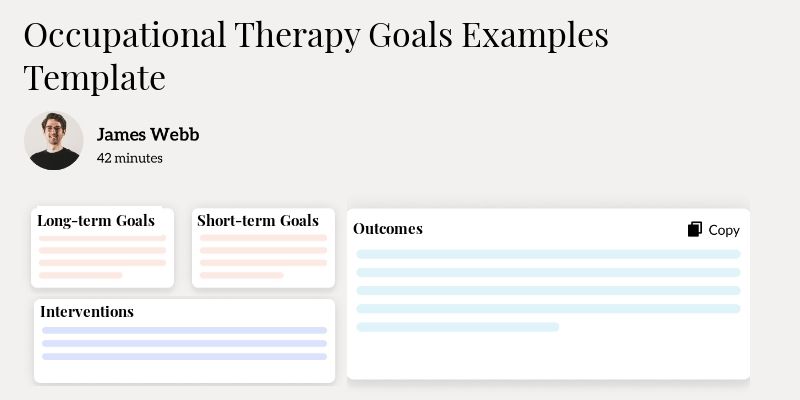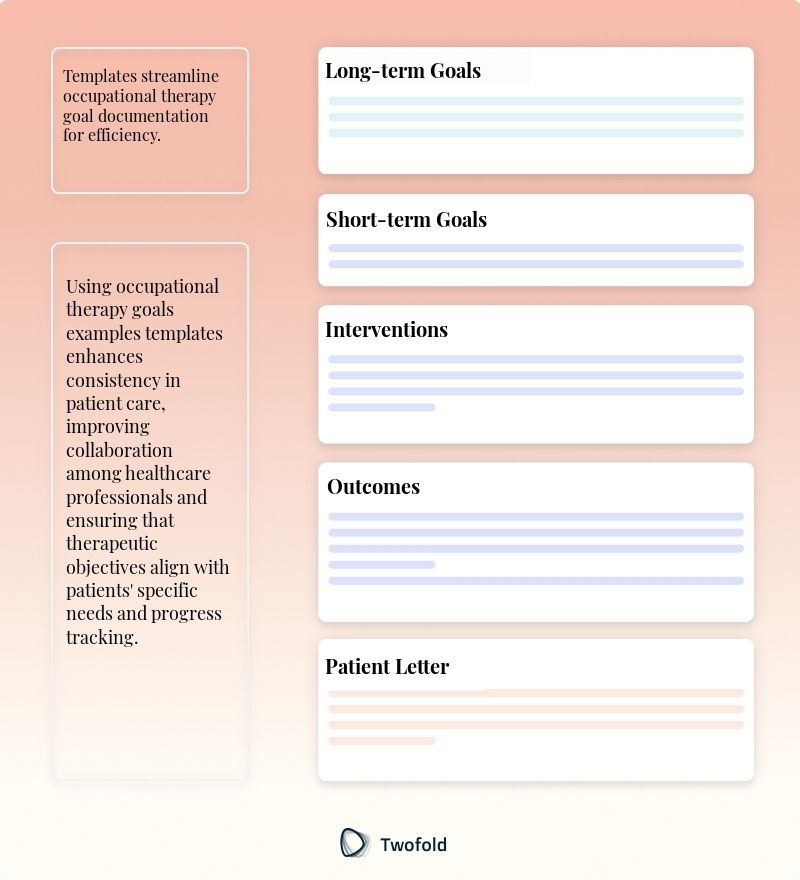
Occupational Therapy Goals Examples Template
Have you ever stared at a blank screen, trying to capture all those occupational therapy objectives without pulling your hair out? You're not alone. Documentation can be daunting, especially if you strive to capture every detail without getting bogged down. But fret not; this article is here to show you how to streamline the process using the Occupational Therapy Goals Examples Template. Let's transform your documentation dread into clarity and precision!
What Is an Occupational Therapy Goals Template?
The Occupational Therapy Goals Template is a structured format used by therapists to document patient goals clearly and methodically. By providing a consistent framework, it assists in setting specific, measurable, attainable, relevant, and time‑bound (SMART) objectives.
This template not only simplifies the goal‑setting process but also ensures all stakeholders understand and can easily follow the treatment path towards achieving the therapeutic outcomes desired.
Key Components of an Occupational Therapy Goals Template
At the heart of an effective Occupational Therapy Goals Template are several critical components:
- Patient Information: Basic details to individualize the template to each patient.
- Goal Description: A clear articulation of therapy goals.
- Measurement Criteria: Specific benchmarks to assess progress.
- Timeline: Estimated timeframes for achieving the goals.
- Intervention Plan: Steps and strategies necessary to meet the goals.

How to Use an Occupational Therapy Goals Template: Step-by-Step Process
Step 1: Gather Patient Data
Collect all relevant information, ensuring you have an accurate understanding of the patient’s history and current needs.
Step 2: Define Specific Goals
Use the template to outline clear, specific objectives tailored to the patient's therapeutic journey.
Step 3: Set Measurement Parameters
Determine how progress will be quantified, whether through observations, standardized assessments, or patient feedback.
Step 4: Plan Interventions
Develop a detailed intervention strategy that aligns with the patient's abilities and the goals outlined.
Step 5: Implement and Review
Put the plan into action and routinely review the goals and progress to ensure the therapy remains effective and relevant.
Benefits of an Occupational Therapy Goals Template
Benefits | Description |
|---|---|
Consistency | Ensures uniformity in documentation across sessions. |
Clarity | Provides clear direction for therapy sessions. |
Efficiency | Saves time in crafting and reviewing therapy goals. |
Accountability | Fosters a sense of duty towards achieving specified outcomes. |
Collaboration | Facilitates shared understanding among team members and families. |
Stakeholders in Occupational Therapy Goals
Successful occupational therapy relies on a web of connected stakeholders:
- Patients: For instance, John, recovering from a stroke, provides insight into his daily challenges, shaping his functional goals.
- Family Members: Sarah's parents discuss her school environment to incorporate relevant tasks in her therapy.
- Healthcare Providers: A collaborative effort with Dr. Smith ensures Emma's therapy aligns with her post-surgery recovery protocol.
- Therapists: Occupational therapists like Marc execute documented goals and assess patient progress regularly.
Example of an Occupational Therapy Goals Template PDF
For a practical understanding, here is an example of an Occupational Therapy Goals Template available as a PDF. This visual aid ensures consistency in documentation practices.
Real-World Use Cases: Practical Impact of the Occupational Therapy Goals Template
Occupational therapy goals have real‑world significance that extends beyond clinical documentation:
- Emily, a young mother, sees a marked improvement in daily activities, feeling empowered by her regained ability to care for her child independently.
- Mike, a retiree, navigates community spaces with confidence due to targeted mobility goals that enhance his social life.
- Anna, a school-aged child, achieves better academic performance from therapy integration into her school routine, emphasizing practical applications of skills learned in therapy.
Conclusion
To sum up, the Occupational Therapy Goals Template serves as an indispensable tool in structuring therapy objectives. By clearly defining and tracking goals, therapists not only work efficiently but also engage patients and their families in meaningful, transformative ways. With practical examples and step‑by‑step guidance, incorporating this template into your practice promises to enhance the quality and impact of occupational therapy sessions.
Disclaimer: This article is for informational purposes only and does not constitute legal or medical advice. Always consult professional guidelines and regulatory bodies for specific compliance requirements.

Dr. Danni Steimberg
Dr. Danni Steimberg is a pediatrician at Schneider Children’s Medical Center with extensive experience in patient care, medical education, and healthcare innovation. He earned his MD from Semmelweis University and has worked at Kaplan Medical Center and Sheba Medical Center.
OT goals work best when they are occupation‑first, measurable, and easy to progress. Use COAST‑Plus ‑ Client, Occupation, Assist level, Specific conditions, Timeline + Performance metric ‑ to turn examples into goals you can track and advance.
- Lead with the occupation: Write the task the client actually needs to do, then add assist level and context. Example: "Client will button a front-opening shirt with minimal assist while seated at edge of bed within 3 weeks."
- Add a performance metric: Quantify quality or efficiency so success is obvious. Example: "Prepare a simple meal in under 12 minutes with 0 safety prompts and pain ≤3/10."
- Stage the progression: Include the next rung so the goal ladder is clear. Example: "After minimal assist is met, progress to supervision, then independent with adaptive button hook removed."
Frequently Asked Questions
Reduce burnout,
improve patient care.
Join thousands of clinicians already using AI to become more efficient.

Urgent Care Note Template
Discover practical Urgent Care Note templates to enhance your documentation efficiency.

Medical Chart Template
Discover practical Medical Chart templates to enhance your documentation efficiency.

SOAP Note Template
Discover practical SOAP Note templates to enhance your documentation efficiency.

